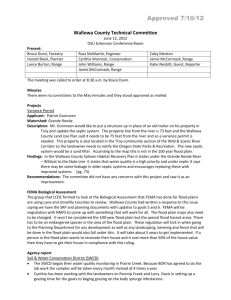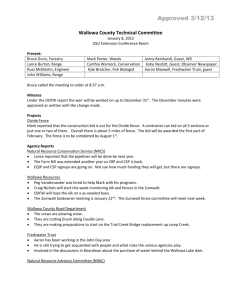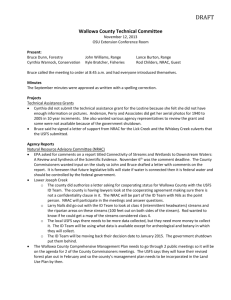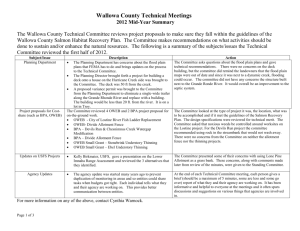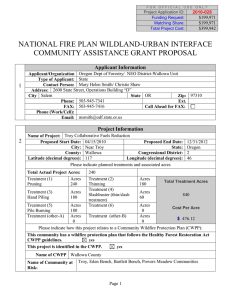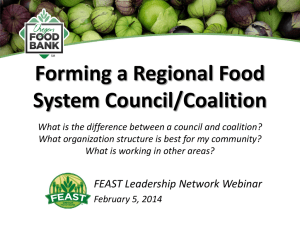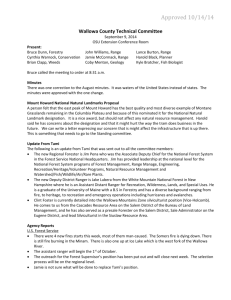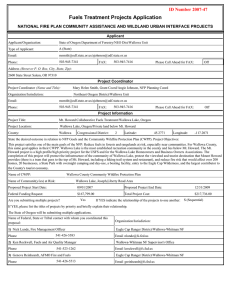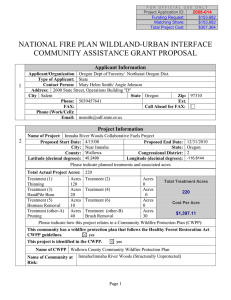Project Summary Form Id Number 2006-105
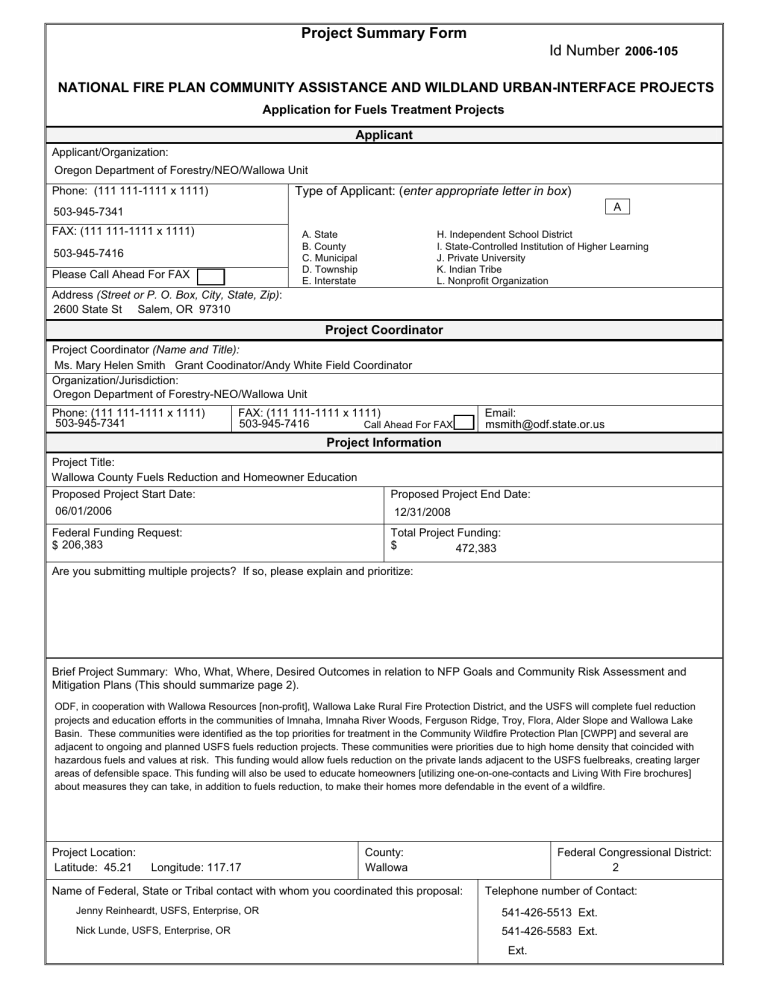
Project Summary Form
Id Number
2006-105
NATIONAL FIRE PLAN COMMUNITY ASSISTANCE AND WILDLAND URBAN-INTERFACE PROJECTS
Application for Fuels Treatment Projects
Applicant
Applicant/Organization:
Oregon Department of Forestry/NEO/Wallowa Unit
Phone: (111 111-1111 x 1111) Type of Applicant: ( enter appropriate letter in box )
503-945-7341
FAX: (111 111-1111 x 1111)
503-945-7416
Please Call Ahead For FAX
Address (Street or P. O. Box, City, State, Zip) :
2600 State St Salem, OR 97310
A. State
B. County
C. Municipal
D. Township
E. Interstate
A
H. Independent School District
I. State-Controlled Institution of Higher Learning
J. Private University
K. Indian Tribe
L. Nonprofit Organization
Project Coordinator
Project Coordinator (Name and Title):
Ms. Mary Helen Smith Grant Coodinator/Andy White Field Coordinator
Organization/Jurisdiction:
Oregon Department of Forestry-NEO/Wallowa Unit
Phone: (111 111-1111 x 1111)
503-945-7341
FAX: (111 111-1111 x 1111)
503-945-7416 Call Ahead For FAX
Project Information
Project Title:
Wallowa County Fuels Reduction and Homeowner Education
Proposed Project Start Date:
06/01/2006
Email: msmith@odf.state.or.us
Proposed Project End Date:
12/31/2008
Federal Funding Request:
$ 206,383
Total Project Funding:
$
472,383
Are you submitting multiple projects? If so, please explain and prioritize:
Brief Project Summary: Who, What, Where, Desired Outcomes in relation to NFP Goals and Community Risk Assessment and
Mitigation Plans (This should summarize page 2).
ODF, in cooperation with Wallowa Resources [non-profit], Wallowa Lake Rural Fire Protection District, and the USFS will complete fuel reduction projects and education efforts in the communities of Imnaha, Imnaha River Woods, Ferguson Ridge, Troy, Flora, Alder Slope and Wallowa Lake
Basin. These communities were identified as the top priorities for treatment in the Community Wildfire Protection Plan [CWPP] and several are adjacent to ongoing and planned USFS fuels reduction projects. These communities were priorities due to high home density that coincided with hazardous fuels and values at risk. This funding would allow fuels reduction on the private lands adjacent to the USFS fuelbreaks, creating larger areas of defensible space. This funding will also be used to educate homeowners [utilizing one-on-one-contacts and Living With Fire brochures] about measures they can take, in addition to fuels reduction, to make their homes more defendable in the event of a wildfire.
Project Location:
Latitude: 45.21 Longitude: 117.17
County:
Wallowa
Federal Congressional District:
2
Name of Federal, State or Tribal contact with whom you coordinated this proposal: Telephone number of Contact:
Jenny Reinheardt, USFS, Enterprise, OR
Nick Lunde, USFS, Enterprise, OR
541-426-5513 Ext.
541-426-5583 Ext.
Ext.
Project Narrative Description
Applications for funding must include a narrative response that describes the proposal. Please do not submit responses longer than one page, single space, 12-pitch font.
Describe project including, but not limited to:
Address these items x project location (e.g., Watershed, neighboring community) as applicable: x anticipated outcomes x community partners and their role(s) x x x x project relationship to the community risk assessment and mitigation plan amount or extent of actions (acres, number of homes, etc.) project timeline and matching or contributed funds proponent’s ability to complete project
For this project, explain the level of cooperation, coordination or strategic planning, through a “Local Coordination
Group.” If you have not worked with a local coordination group, why not?
The LCG helped devise the Community Wildfire Protection Plan and thus the priorities for this grant.
Is this project adjacent to a current prescribed burn project on federal lands or to one that is planned within the next three years? (Yes/No)
Yes
Please indicate planned treatments and associated acres:
* Treatment Acres Treatment Acres 328
0
If you have a treatment type other than standard types above:
Location: Projects will occur in the communities of Imnaha, Imnaha River Woods, Ferguson Ridge, Troy, Flora, Alder Slope and Wallowa Lake
Basin. These communities are located in the Wallowa River and Imnaha River Watersheds. These communities surround the town of Enterprise, which is the Wallowa County Seat.
Outcomes: To reduce fuels, thin, prune, and treat the slash for 328 acres of forestland in the wildland urban interface areas identified in the Wallowa
County Community Wildfire Protection Plan [CWPP]. Slash treatment will take the form of chipping and burning primarily, however if an opportunity rises to utilize biomass, that option will be taken advantage of. Wallowa Resources and Wallowa Lake Rural Fire District will employ their existing field personnel to administer projects in the Alder Slope and Wallowa Lake Basin communities to reduce administration costs, should this grant be approved. These two entities along with ODF will coordinate with the USFS to take advantage of opportunities to work across ownership boundaries to increase the size of fuel breaks and defensible space [landscape-level approach]. An additional outcome of this project is to educate homeowners on additional measures they can take, in addition to fuels reduction, to make their property and homes more defendable in the event of a wildfire.
Project relationship to community risk assessment: These projects are a direct result of the community risk assessment process from which the
Community Wildfire Protection Plan [CWPP] was derived. These communities are listed as priorities for fuels treatment in the CWPP due to high home densities that coincided with hazardous fuels, high fire occurrence and values at risk. This 328 acres of treatment will include 65-80 homesites and the hazardous fuels that separate them. This acreage also includes hazardous fuels that separate USFS fuel breaks from defensible space treatments on private land in order to create a landscape-level approach to treating fuels.
Project timeline and matching or contributing funds: This project is scheduled to start on 4/1/06 and to end on 12/31/08. Wallowa Resources will contribute $5,000 of their personnel time to administer the fuels reduction projects in the Alder Slope community. Wallowa Lake Rural Fire
Protection District will also contribute $5,000 of personnel time to administer these projects in the Wallowa Lake Basin community. ODF will contribute $7,000 of personnel time to administer and coordinate this grant at the county level.
Ability to complete project: Given the high level of assistance from the local cooperators, and the interest from the local workforce and homeowners, our ability to achieve this goal is very high. Time was taken to involve these communities, through community meetings, in the development of the
CWPP and thus interest in these communities is very high. We also have demonstrated success in past National Fire Plan projects that we have implemented.
Project Evaluation Criteria
Applications for funding must include narrative responses that address the following three criteria. Be sure you address every one briefly, yet thoroughly.
Limit your responses to the area provided .
1.
Reducing Hazardous Fuels (50 points)
A. Describe the community infrastructure that will be protected.
B. Explain how the proposal reduces fire behavior in high hazard areas by describing the fuels to be disposed or removed, and the techniques and timing of the treatments.
C. How will the proposed treatments be maintained in future years?
D. How will you use multi-party monitoring to improve this and future projects?
Response:
A. Infrastructure to be protected includes high voltage power lines, telephone lines, radio repeaters, city/community watersheds, granges, water treatment facilities, highway and road access, and overall aesthetics of Wallowa County.
Several of the high hazard areas proposed for treatment contain high-voltage powerlines [from dams on the Snake River] as well as telephone lines. Where possible, proposed treatments encompass both defensible space for the homes as well as the utility lines. Radio repeaters utilized by all Emergency Services and natural resources entities in the county are also within/adjacent to these areas of proposed treatment are built into the fuels reduction projects. Primary highway/road access is compromised by hazardous fuels in several of the communities proposed for treatment and will be addressed by treating the fuels adjacent to the road systems. Several city/community watersheds, granges and water treatment facilities are within and/or adjacent to the areas of proposed treatment and the fuels reduction treatments will encompass as much of these values as possible. The overall aesthetics of the county, especially in the Wallowa Lake Basin, Alder Slope, and Ferguson Ridge communities are an important part of the economy in Wallowa County as many outdoor enthusiasts/tourists visit the county each year. On-going and proposed treatments will reduce the risk of large, devastating wildfires on the private lands in these areas.
B. This proposal targets the high hazard areas in these communities which are dominated by pine and mixed conifer stands with an understory of shrub and shade tolerant conifers, providing ladder fuels into the overstory. Treatments will include removal of down and dead material, thinning of standing trees & shrubs, both live and dead, and the pruning of residual stands to a maximum height of 15 ft. Chipping or burning will be the primary treatment of all debris from these projects. Limitations with regard to Ips beetle will affect timing of treatments.
Currently, the county is working on a proposal for a biomass facility to heat the Wallowa School District in Wallowa, OR. Should this occur, ODF would facilitate a discussion between the biomass facility and private landowners to develop a process to utilize as much of the debris from these projects as possible. Previous NFP grants helped fund a "post and pole" plant in Wallowa, and some trees removed during this project will be utilized at this facility.
In additon, this proposal is utilizing the Living With Fire newspaper to inform homeowners on measures they can take to make their homes and property more defensible and thus less of a fire hazard. Green space created can be 100-300 ft. around the homesite.
The timing of treatments in pine stands will be between September and December to avoid problems with the IPS bark beetle. If all material is chipped or otherwise removed from the site, then treatments could occur year-round as in the mixed conifer stands.
C. All projects will be maintained by the private landowners. Since these are cost-share projects, the landowners must contribute labor and/or funding to complete them. Landowners sign an agreement that the project, once completed, will be maintained for 10 years. All the cooperators involved in these projects will also be using the Living with Fire brochures as an educational tool to not only inform homeowners about the benefits /options involved in fuels reduction but also to emphasize the importance of maintaining these projects. Implementation of Oregon SB 360 will also be an incentive to maintain forested property.
D. Multi-party monitoring works well given the number of cooperators involved in these projects. There are agreements in place for different entities to administer and track projects by location. By tracking the status/condition of these projects over time, we will verify the effectiveness.
Project Evaluation Criteria
2. Increasing Local Capacity (25 points )
A. How would the proposal improve or lead to the improvement of the local economy in terms of jobs and sustainable economic activity?
B. How many jobs are expected to be created or retained and for how long? (Please distinguish between essentially year-round and seasonal jobs).
C. What tools and skills will be gained or utilized as a result of this project?
D. Will biomass be utilized; if so, in what manner and how much?
Response:
A. A significant amount of the labor completed on past fuels reduction projects have been accomplished by local contractors, who are then able to keep their seasonal workers employed longer. Some contractors have hired additional seasonal workers, and in some cases permanent workers, to work primarily on these projects. These jobs would not be considered sustainable, however, as many could end once the NFP funding ends.
B. Some material from the projects proposed in this grant application would support five recently created jobs at a year-round Post and Pole Facility. In addition, the funding in this grant that is devoted to the on-the-ground projects, typically performed by contractors, would fund the equivalent of 7 year-round jobs, based on the county average wage. Based on previous fuels reduction grant projects, it is estimated that this funding would extend the season of 8-10 current seasonal employees and potentially allow 1 or
2 jobs be maintained year-round.
C. Tools and skills gained or utilized: 1] interpreting silvicultural prescriptions, 2] identification of tree and shrub species using multiple methods 3] techniques of thinning, pruning, burning & chipping 4] education Living With Fire educational materials.
D. Wallowa Resources is planning to utilize biomass from these projects in small boiler units to heat schools; also, we send what qualifies to a post and pole plant and utilize what we can for the Warm Hearts,Warm Homes firewood program.
3. Demonstrating Community and Intergovernmental Collaboration (25 Points)
A. How will this project implement a community risk assessment and mitigation plan? Include name of plan, date it was prepared, and local contact to get a copy of the plan if requested.
B. How has this treatment been coordinated with adjacent landowners and local/State/Tribal/Federal agencies?
C. Identify the cooperators/partners involved in implementation of this project.
D. Describe the extent of current local support for the project, including any cost-sharing agreements.
Response:
A. This project focuses on priority areas identified in the recently completed Community Wildfire Protection Plan [CWPP]. All local partners were included in this process [USFS, ODF, EMS, County Government, Rural Fire Districts, private landowners, Natural
Resource Advisory Committee, Nez Perce Tribe, Oregon Employment Dept. as well as others]. The latest version of this plan was completed January 16, 2005. The document is undergoing it's third revision. You may contact Nils Christofferson, Chairman of the
Wallowa County CWPP, at [541]426-8053. Or, download a copy at http://www.odf.state.or.us/areas/eastern/northeast/ wallowaco_cwpp.htm.
B] Coordination of treatments has taken place at public meetings where the interest of communities to participate in these projects was solicited. Coordination with the USFS has already occurred to identify locations where we can work across property boundaries. Wallowa Resources, homeowners associations, and Rural Fire Districts are gathering the names of interested homeowners in an effort to streamline the implementation of the on-the-ground work.
C] Cooperators/partners involved in the implementation of this project are USFS, ODF, Wallowa Resources, Wallowa Lake Rural
Fire Protection District and Wallowa County Emergency Services.
D] Local support is very high for this project, primarily due to the heavy involvement of all entities in the Community Wildfire
Protection Planning process. Agreements are in place with Wallowa Resources and Wallowa Lake Rural Fire Protection District to assist in the implementation phase, should we receive funding.
Project Work Form
Tasks
Inform Local Coordination Group of grant selection. Execute agreements with Wallowa
Resources and Wallowa Lake RFD.
June 1, 2006
Time Frame
Initiate landowner projects in the Imnaha
River Woods Subdivision, adjacent to USFS fuel breaks.
June 1, 2006 - Dec.31,2008
Utilize waiting list of homeowners in Wallowa
Lake Basin area to initiate homeowner projects.
June 1,2006 - Dec.31, 2008
Utilize waiting list of homeowners to initiate projects in Alder Slope community.
June 1, 2006 - Dec. 31, 2008
Initiate projects in Troy area.
June 1, 2007 - Dec 31, 2008
Responsible Party
Oregon Department of Forestry
Oregon Department of Forestry in cooperation with USFS
Wallowa Lake Rural Fire Protection
District
Wallowa Resources
Oregon Department of Forestry
Project Budget
Wallowa Resources Wallowa Lake RFD Landowners
Cost Category
Description
Personnel
Federal
Agency Applicant Partner 1 Partner 2 Partner 3
Total
NRS1/NRS2 Personnel
ODF match
Subtotal
Fringe Benefits
Other Personnel Expense
$16,000
$0
$16,000
$0
$199,000
$199,000
$5,000
$0
$5,000
$5,000
$0
$5,000
$0
$0
$0
$26,000
$199,000
$225,000
$13,700
$0
$13,700
$2,000
$0
$2,000
$0
$0
$0
$0
$0
$0
$0
$0
$0
$15,700
$0
$15,700
Subtotal
Travel
$0
$0
$0
$0
$0
$0
$0
$0
$0
$0
$0
$0
$0
$0
$0
$0
$0
$0 Subtotal
Equipment
$0
$0
$0
$0
$0
$0
$0
$0
$0
$0
$0
$0
$0
$0
$0
$0
$0
$0
Subtotal
Supplies
Living With Fire Material $300
$0
$300
$0
$0
$0
$0
$0
$0
$0
$0
$0
$0
$0
$0
$300
$0
$300
Subtotal
Contractual
Fuels reduction work
Subtotal
$164,000
$0
$164,000
Other
Salem 6%(Prot+Financ) $12,383
$0
$12,383 Subtotal
Total Costs
Project (Program)
Income
1
$206,383
$0
$201,000
$0
___________________________________
$0
$0
$0
$0
$0
$0
$0
$0
$0
$5,000
$0
$0
$0
$0
$0
$0
$0
$5,000
$0
$0
$0
$0
$55,000
$0
$55,000
$219,000
$0
$219,000
$0
$0
$0
$12,383
$0
$12,383
$55,000 $472,383
$0 $0
1
Program income is the gross revenue generated by a grant or cooperative agreement supported activity during the life of the grant. Program income can be made by recipients from fees charged for conference or workshop attendance, from rental fees earned from renting out real property or equipment acquired with grant or cooperative agreement funds, or from the sale of commodities or items developed under the grant or cooperative agreement. The use of Program Income during the project period may require prior approval by the granting agency.
